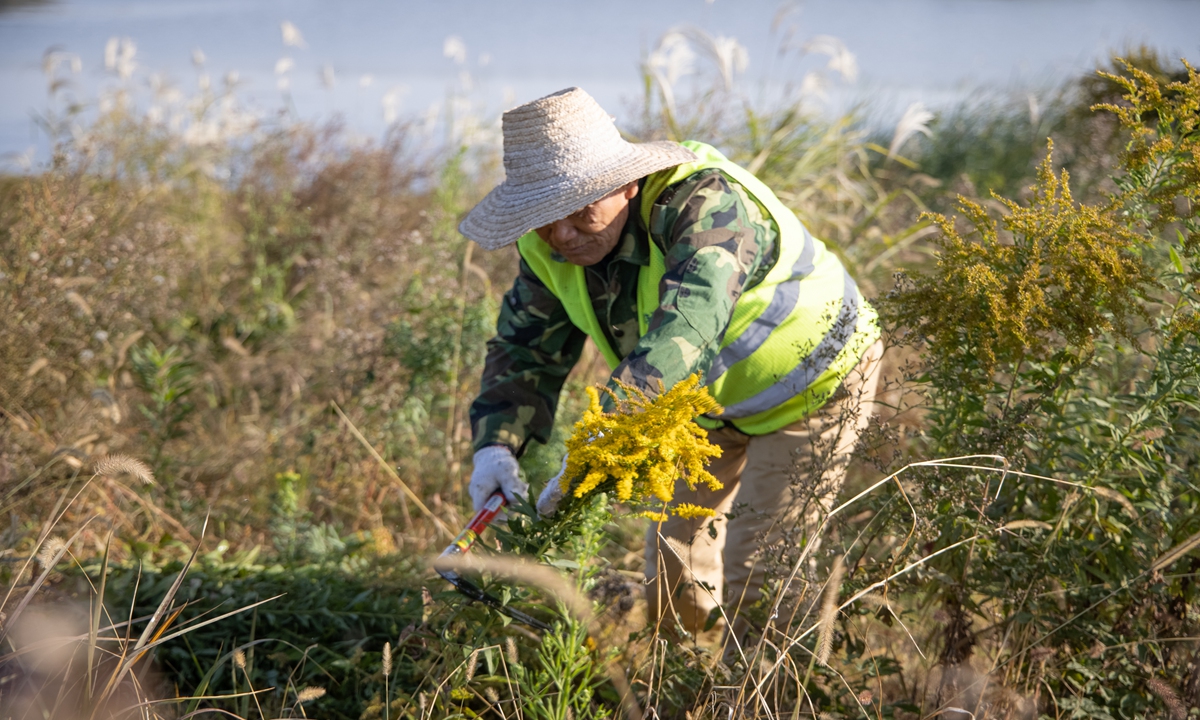
一名男子在中国中部地区的湖北省武汉市消灭加拿大一枝黄花。照片:VCG
The "ecological killer" Solidago Canadensis - also known as the Canadian goldenrod - was once again found in Chengdu, Southwest China's Sichuan Province, only a few days after they were wiped out in the region, a local expert confirmed with the Global Times on Monday.
The invasive plants are notorious for threatening their local counterparts. Due to the Canadian goldenrod's strong reproductive capacity and allelopathic effect on local native plants, it breaks down a stable ecosystem and poses huge threats to local ecosystems, Hou Kai, associate professor, Sichuan Agricultural University told the Global Times on Monday, noting that the local agricultural departments had wiped it out previously.
The species was introduced in the 1930s to China as an ornamental plant. It has led to the elimination of over 30 local species in Shanghai alone, according to media reports.
Over 660 invasive alien species have been found in China, including 71 that have caused threats or potentially will threaten natural ecosystems, according to the most recent news about China's environmental conditions in 2020.
There are several possible channels leading to the invasive species that are being found in China. They could have invaded through nature, such as airflow, water flow or natural migration through plant seeds or animal larvae. Also, human activities have an increasing impact on their invasion.
In order to prevent more invasive species, "public education is needed," Hou said.
The related departments should strengthen the quarantine for imported species, as some invasive species were found in nursery-grown plants or other carriers, Hou said.
Some species are introduced intentionally for the purpose of ornaments, such as Eichhornia crassipes, also named water hyacinth. The related authorities should strengthen their management over these kinds of plants in case they escape or invade other regions, according to Hou.
China has released four batches of lists with invasive species including water hyacinth, Spartina alterniflora and Mikania micrantha. "It is important to educate people about which species are harmful for China's ecological environment, so the release of the lists is very necessary," Hou said.
For those species with worse impacts, the public needs to be aware of the significance to report to the related departments immediately after they find them, Hou said, noting that more research is needed to explore the impact of these invasive species on local ecology and the livelihood of local residents, and scientific and reasonable technology will be used to manage those invasive species.
当地专家周一向《环球时报》证实,“生态杀手”加拿大一枝黄花——也被称为加拿大一枝黄花——在中国西南四川省成都市再次被发现,仅仅几天后,它们就在该地区被消灭了。
入侵植物因威胁当地植物而臭名昭著。四川农业大学副教授侯凯周一对《环球时报》表示,由于加拿大黄花具有强大的繁殖能力和对当地本土植物的化感作用,它破坏了稳定的生态系统,对当地生态系统构成了巨大威胁,农业部门之前已经把它消灭了。
加拿大一枝黄花于1930年代作为观赏植物引入中国。据媒体报道,仅在上海,就有30多种本地物种被消灭。
根据2020年对中国的环境状况的最新消息,已经由超过660外来入侵物种在中国被发现,其中包括71造成威胁或可能会威胁到自然生态系统。
入侵物种在中国发现出现有几种可能。它们可能通过自然入侵,例如气流、水流或通过植物种子或动物幼虫自然迁移。此外,人类活动对其入侵的影响也越来越大。
为了防止更多的入侵物种,“需要进行公共教育”,侯说。
侯说,有关部门应加强对进口物种的检疫,因为在苗圃种植的植物或其他载体中发现了一些入侵物种。
有些物种是为了装饰而有意引进的,例如凤眼莲,也称为水葫芦。侯说,有关部门应加强对此类植物的管理,以防它们逃逸或入侵其他地区。
中国已经发布了水葫芦、互花米草和薇甘菊等四批入侵物种名录。“重要的是要教育人们哪些物种对中国的生态环境有害,因此发布清单是非常必要的,”侯说。
侯说,对于那些影响更严重的物种,公众需要意识到发现它们后立即向有关部门报告的重要性,并指出需要更多的研究来探索这些入侵物种对当地生态和当地生态的影响。当地居民的生计,将采用科学合理的技术来管理这些入侵物种。
原文链接:https://enapp.globaltimes.cn/article/1239574

